| Home > Policy > White Paper, Notice, Announcement > White Paper > JAPANESE GOVERMENT POLICIES IN EDUCATION, SCIENCE, SPORTS AND CULTURE 1995 > Remaking Universities Chapter 2 Section 1 3 | ||
The selection of university entrants has a major influence on education as a whole at the upper secondary school level and below, and thus is the focus of national concern. This interest reflects the excessive emphasis that is placed on academic credentials in Japan, the social tendency to prefer prestigious schools, and the quantitative expansion of higher education.
Universities are working to improve their entrant selection methods. A variety of innovations and enhancements have already been implemented in this area.
The University Council implemented wide-ranging studies based on medium- to long-range perspectives, convinced that approaches to university entrant selection have a major impact not only on higher education but also on education at the upper secondary school level and below and that continuing efforts should be made to discover the best possible methods. The results of these studies were submitted to the Minister of Education, Science, Sports and Culture in September 1993 in a report titled "Deliberations Concerning the Improvement of University Entrance Examinations." This report advocated a variety of changes, including measures to promote the use of the National Center for University Entrance Examinations (NCUEE), the implementation of diversified entrant selection methods that reflect the characteristics of individual universities, and the improvement of the system of admission on recommendation.
A number of factors must be taken into account in the university entrant selection process. In addition to the use of fair and appropriate methods to evaluate ability, aptitude, and the other characteristics needed for university education, it is also necessary to ensure that the selection process does not have a disruptive impact on upper secondary education. This perspective is reflected in the efforts that universities are now making to apply diversified and multiple assessment criteria that reflect the attributes and aims of individual universities and the characteristics of specialized fields and to evaluate applicants from a wide variety of perspectives, including ability and aptitude.
Until the introduction in fiscal 1979 of the Joint First-Stage Achievement Test system, which was the precursor of the NCUEE examination system, there was a tendency for success or failure to be determined by a single achievement test that frequently contained excessively difficult and tricky questions beyond the scope of upper secondary education, partly because tests were administered independently by individual universities. The Joint First-Stage Achievement Test system was seen as an important step forward for several reasons, notably the replacement of excessively difficult and tricky questions with questions of a high standard that enabled examiners to evaluate each student's basic level of achievement in upper secondary education. The system also attracted criticism, however. For example, it was seen as aggravating the problem of "university ranking," partly because it was based in principle on five uniform subject areas.
These considerations, as well as the deliberations of the National Council on Educational Reform, resulted in the replacement of the Joint First-Stage Achievement Test system with the NCUEE examination system, starting with the fiscal 1990 entrance examinations. Unlike the Joint First-Stage Achievement Test system, which required all students to take examinations in five uniform subject areas, the NCUEE system gives universities greater latitude with regard to the selection and weighting of the subject areas used in the selection process while maintaining a high standard of examination questions. The result is an "agrave; la carte" system. For example, it is now possible to take examinations in a single subject area. By using the system in various ways according to their own judgment and philosophies, universities can administer entrance examinations that reflect their specific characteristics instead of relying on uniform tests. In addition, simplistic comparisons based on aggregate scores on achievement tests have been abolished, with the aim of preventing the examination system from aggravating the problems of "university ranking" and total reliance on "standard scores" in deciding what universities to apply to.
The NCUEE system is designed to improve entrance examinations at universities of all types; the system can be used by private as well as national and local public universities. The number of private universities using the system has been increasing steadily over the years, and in fiscal 1996 a total of 122 plan to utilize NCUEE examinations ( Table 2.1 ).

It is important for individual universities to enhance their entrant selection methods by using diversified and multiple assessment criteria that reflect universities' aims and characteristics and those of their faculties, as well as the characteristics of specialized fields, and by evaluating applicants on the basis of a wide range of abilities, aptitudes, and other attributes. In recent years a growing number of universities have sought to achieve these goals by relying not only on achievement tests but also on such methods as interviews, essays, and practical tests. Moreover, an increasing number of universities have introduced admission on recommendation and special selection methods for various types of applicants, including adult students and children returning from overseas. Beginning in fiscal 1996 there will be a special selection method for graduates of specialized upper secondary schools. Universities are currently studying its introduction.
A growing number of universities are selecting students on the basis of interviews and essays, without requiring them to take any scholastic tests other than the NCUEE examinations. One university's school of medicine has established a selection system designed to identify students with the intellectual, moral, and physical characteristics appropriate to physicians. Instead of relying on entrance examinations, which are skewed toward scholastic achievement, the school requires applicants to list their volunteer and sports activities and other activities on evaluation forms designed by the school. This method enables entrants to be selected on the basis of a wide range of activities in addition to scholastic achievement at the upper secondary school level.
In fiscal 1987 the "consecutive pattern" was introduced as a way of providing students with multiple opportunities to take entrance examinations for national and local public universities. Under this system each university administers examinations in one phase, using two schedules (A and B). Since fiscal 1989 this approach has been combined with the "separating and dividing pattern," whereby a university establishes separate quotas for individual faculties and administers examinations in two phases ( Figure 2.2 ). Starting with the fiscal 1997 entrance examinations for national universities and the fiscal 1999 entrance examinations for local public universities, the "separating and dividing pattern" will become the uniform entrance examination method. The aim of this move is to provide applicants with more diverse opportunities for choice.
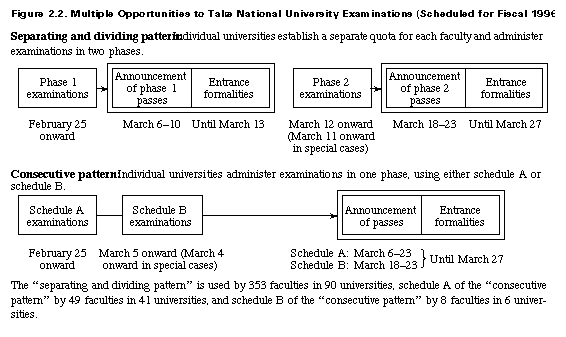
The admission on recommendation system is playing a significant role in the diversification of university entrance examinations. In recent years, however, there has been concern that the system is having an adverse impact on upper secondary education because of its use in some cases simply as a way of securing more students as quickly as possible. For example, some universities
In its 1993 report the University Council recommended specific improvements to the system. First, there should be total exemption from scholastic tests. Second, there should be a time threshold, such as November, for the start of the admission on recommendation process. And three, admission on recommendation should have a ceiling of about 30% of entrants to four-year universities and about 50% of entrants to junior colleges. Universities and junior colleges are currently working to improve their systems in line with these recommendations.
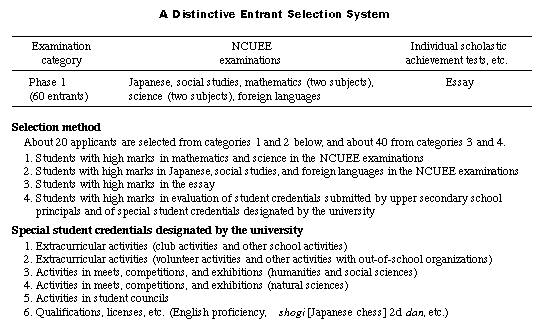
University applicants tend to be influenced unduly in their career choices by "standard scores." This tendency causes a number of problems, including the "ranking of universities" and students entering universities that they do not really wish to attend. To overcome these problems, it is necessary to ensure that students have adequate access to information that will help them to make career choices, including information about specific universities' education, research, and entrance examinations.
The NCUEE uses the CAPTAIN communications network established by NTT (Nippon Telegraph and Telephone Corporation) to supply upper secondary schools and other upper secondary educational institutions with information about education and research and other aspects of universities and university faculties under the HEART System * , which was introduced in fiscal 1988. Information about transfer admission has been supplied since fiscal 1992, and information about university reform since fiscal 1993.
Individual universities are also working actively to supply information. The methods used include the organization of briefings on the university, the production of videos and brochures describing various faculties, and the operation of telephone information lines.
* HEART System (Higher Education Articulation Support System):
Under this system the NCUEE maintains a database of information about education, research, and other aspects of universities throughout Japan and distributes it to upper secondary schools and other upper secondary educational institutions through NTT 's CAPTAIN communications network. The HEART System can be used to obtain information about specific universities. In addition, the system provides instant access to information about what universities in Japan have the faculties, courses, and other features sought by individual applicants. The information access menu includes five items:
Starting with the selection of university entrants in fiscal 1997, it will be necessary to implement scholastic tests that reflect the Course of Study for Upper Secondary Schools introduced in April 1994. The NCUEE plans to respond to the diversification of subjects studied at upper secondary schools by expanding the range of subjects covered in entrance examinations from the present 18 subjects in five areas to 34 subjects in six areas. From fiscal 1997 onward universities will need to ensure that scholastic tests and other selection methods appropriately evaluate applicants on the basis of attributes emphasized in the 1994 Course of Study, such as willingness to learn independently and ability to think, judge, and express oneself.
In January 1995 MESSC commissioned a private research organization to conduct a survey titled "Survey on Future Issues of University Reform." The results outlined below relate to undergraduates' wishes in regard to universities, class attendance, and other points. Fugure 2.3. Reasons for Selecting a Particular Universities
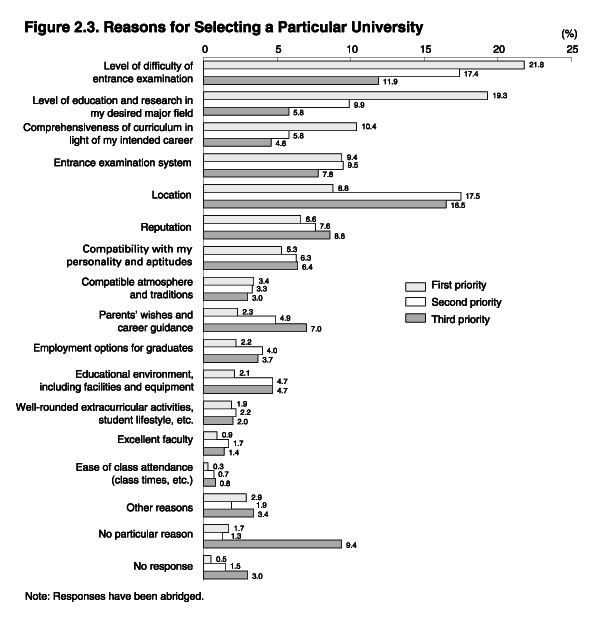 1. "Level of education and research in my desired major field" ranked high among the aspects taken into account when selecting a university ( Figure2.3 ). Students were asked to state the top three priorities that had guided their choice of university. "Level of difficulty of entrance examination" was the first priority for 21.8% of respondents, and "level of education and research in my desired major field" was the first priority for 19.3%. "Level of difficulty of entrance examination" was cited as the second priority by 17.4% and as the third priority by 11.9%. "Location" was the second priority for 17.5% and the third priority for 16.5%. 2. The average time students spent attending classes was 19.3 hours a week ( Table 2.2 ). On average students spent 19.3 hours a week attending classes, participating in experiments and practical training, and so on. The figures for individual fields were 22.3 hours a week for the natural sciences, 19.9 hours a week for the humanities, and 15.8 hours a week for the social sciences. 3. Students are enthusiastic about study activities outside university ( Figure 2.4 ). Respondents were asked about their studies outside university, such as in special training colleges and miscellaneous schools or by correspondence. The majority (58.5%) stated that they were not involved in this kind of "two-track schooling," but 13.1% were currently involved in such activities, 8.6% said that they had been involved in the past, and 19.2% said that they were considering involvement. Those currently studying outside university and those who had done so in the past together accounted for 29.1% of third-year students. 4. Students have a variety of wishes concerning classes and curriculum. Respondents were asked to state up to three wishes concerning university classes and curriculum. (1) Useful, easy-to-understand classes wanted ( Figure 2.5 ) :When asked to state their wishes about university classes, the majority of respondents stated that they wanted classes to be "easy to understand" (56.3%) and provide "useful content" (53.1%). The proportion wanting classes to be "easy to understand" was highest (65.7%) among natural science students. The percentage of students wanting "subjects not covered or not understood at upper secondary school level" was also higher among natural science students (17.0%) than among students in other fields. (2) Strong preference for specialized education and job preparation indicated ( Figure 2.6 ) :The most frequent responses when respondents were asked to state their wishes concerning curriculum were "better specialized education" (36.3%), "curriculum useful for acquiring qualifications or in work" (35.3%), "more specialized education available in first and second years" (26.6%), and "fewer credits required for graduation" (25.6%). The percentage wanting "supplementary coverage of subjects not covered adequately at upper secondary school level" was highest among natural science students (11.6%), while the social sciences led in the percentage of students wanting a curriculum that would help them gain qualifications or would be useful in their work (41.2%). 5. Students desire reform ( Figure 2.7 ). Respondents were asked to state their level of satisfaction with their universities in 20 categories. Overall, many respondents opted for "neither satisfied nor dissatisfied." "Satisfied" includes "extremely satisfied" and "somewhat satisfied," while "dissatisfied" includes "extremely dissatisfied" and "somewhat dissatisfied."The categories in which satisfaction was high included "specialized courses" (47.7%), "health and physical education courses" (46.0%), "foreign language courses" (36.0%), "quality and quantity of curriculum guidance about the new term" (32.6%), "seminars" (32.0%), and "general education courses" (31.7%). The categories in which dissatisfaction was high included "teaching methods, including diction and use of blackboard" (42.4%), "courses for gaining jobs or qualifications" (39.3%), "Information processing courses" (37.8%), "class content" (35.1%), "contact with teachers" (34.7%), "textbooks" (32.5%), and "auditing of and credit for courses in other faculties and universities" (27.8%). Talbe 2.2.class Attendance
 Figure 2.4. Study Activities Outside University
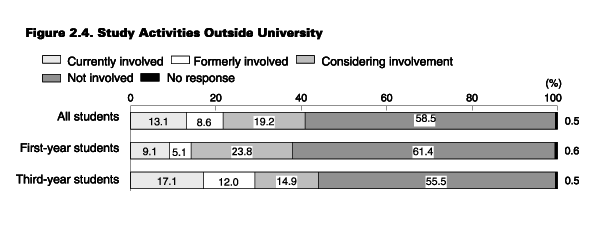 6. Students want continuity with upper secondary education ( Figure 2.8 ). The percentage of students responding in the affirmative when asked if they were experiencing difficulty with university subjects that were not provided at the upper secondary school level was highest among natural science students (39.8%), followed by social science students (31.0%) and students of the humanities (23.0%). 7. Admission opportunities are available for adult students, but reconciling study and work is difficult ( Figure 2.9 ). Multiple responses were sought concerning adult students ' attitudes to university education.* Over half felt that there were "adequate opportunities for admission of adult students" (53.8%). Few, however, agreed with the statement "Study and research possible without hindering work" (7.8%). These results can probably be attributed to the fact that the survey covered adult students who had already been admitted to universities. It is apparent both that universities must make themselves more open and that the understanding of society is needed. *The term "adult students" as used in this survey refers to people who have entered university after experience in the work force, including people admitted to universities through special selection procedures for adults (selection under adult-student quotas established in entrance examination systems) and people with work experience (including housework) who have been admitted through general entrance examinations, as well as students currently employed and evening-course students holding jobs (excluding part-time workers). The survey results indicate that students in this age of widespread higher education are strongly motivated to learn and that efforts are being made to enhance educational content and methods. In this sense, the results are encouraging. Yet the results also show that many students are dissatisfied with university education. Alleviation of this problem will depend on universities' future reform efforts. Figure 2.5. Wishes Concerning Class
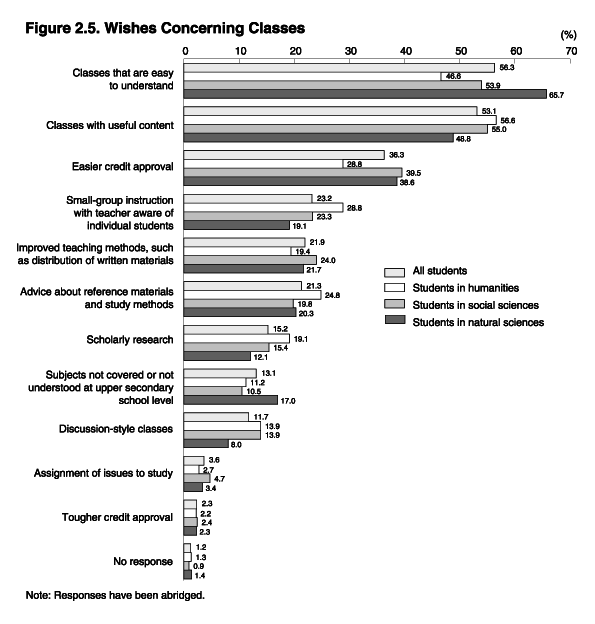 Figure 2.6. Wishes Conserning Curriculum
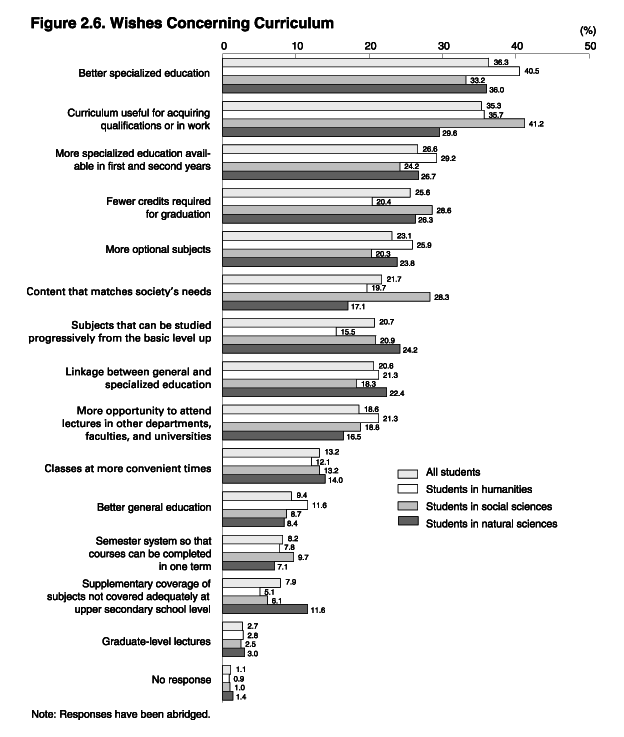 Figure 2.7. Satisfaction with Universities
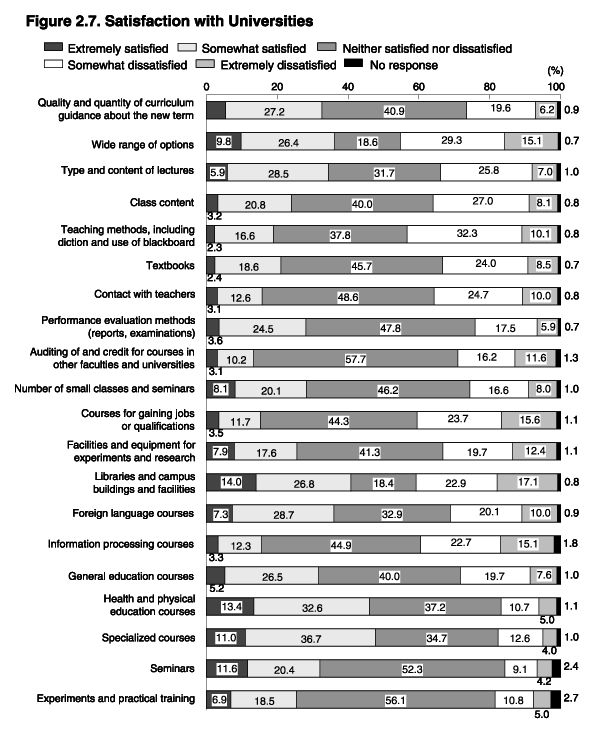 Figure 2.8. Continuity with Upper Secondary Education
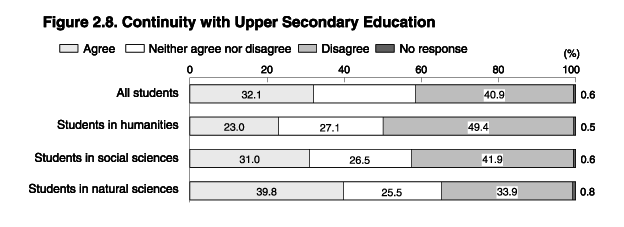 Figure 2.9. Adult Srudents' Attitudes to University Education
 |
| Back to Top | MEXT HOME |